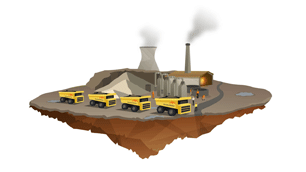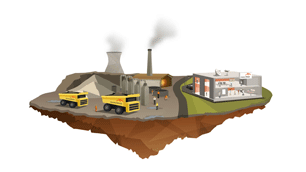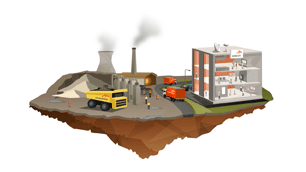The steel industry is a carbon-intensive industry. As the world's largest steel producer, we have one of the world’s largest corporate carbon footprints. Yet we see steel as having a vital role to play in a low-carbon, resource-efficient future. We are embracing this opportunity through an approach that drives emission reductions through technological innovation, collaboration with other industries, and energy efficiency gains.
Why is this important to us?
The economy of the future will be low-carbon and one day, it will be zero-carbon. Energy efficiency will be based on circular approaches to resources. Steel is an ideal material with which to build such a future, because of its inherent virtues of durability, strength and recyclability. We need to ensure that steel – and our steel in particular – is at the centre of such an economy, so that we can continue to create value for stakeholders. At the same time, we see immediate advantages – for example, energy costs go directly to our bottom line. So, gains in energy efficiency strengthen our competitiveness.
Our challenge

Adapting our operations for the move to a low-carbon future is one of the toughest issues we face. Today there’s an enormous opportunity to transform the way steel is made, yet current policy frameworks are not encouraging investment in the kind of breakthrough technologies we need to move to low-emissions steelmaking. In fact, our greatest climate-related risk is in markets that are developing local carbon regulatory systems at a regional or national level, such as Europe. These local systems are good, but also the weakest link. Since steel is easily shipped around the world, there is a risk that unregulated steel will outcompete steel covered by local carbon pricing schemes.
Our action

We need to ensure the right conditions to invest in low-carbon breakthrough technologies. We are ready to develop low-emissions steelmaking, but there are three conditions we need: a level playing field to ensure that carbon is regulated in a fair way globally; the right policy frameworks to incentivise investment in new low-carbon technologies; and the rapid growth of abundant, affordable, renewable energy to power these technologies. At the same time, we must continually improve our efficiency in our use and reuse of energy within our own operations and in neighbouring networks, and continue to recycle the limited scrap supplies available globally.
Our potential to create value

We want to strengthen our business by addressing policy risks, reducing energy costs and opening up significant new commercial opportunities through the reuse of carbon. Steelmakers have always used carbon to create value through steelmaking, via the use of coal and coke to reduce iron ore. Currently, the resulting CO2 is treated as waste - but we're exploring technologies that will convert it into high-value products. In addition, we believe that there are ways to use society's waste in place of coal in the blast furnace, thereby closing the carbon loop and reducing both emissions and waste.
